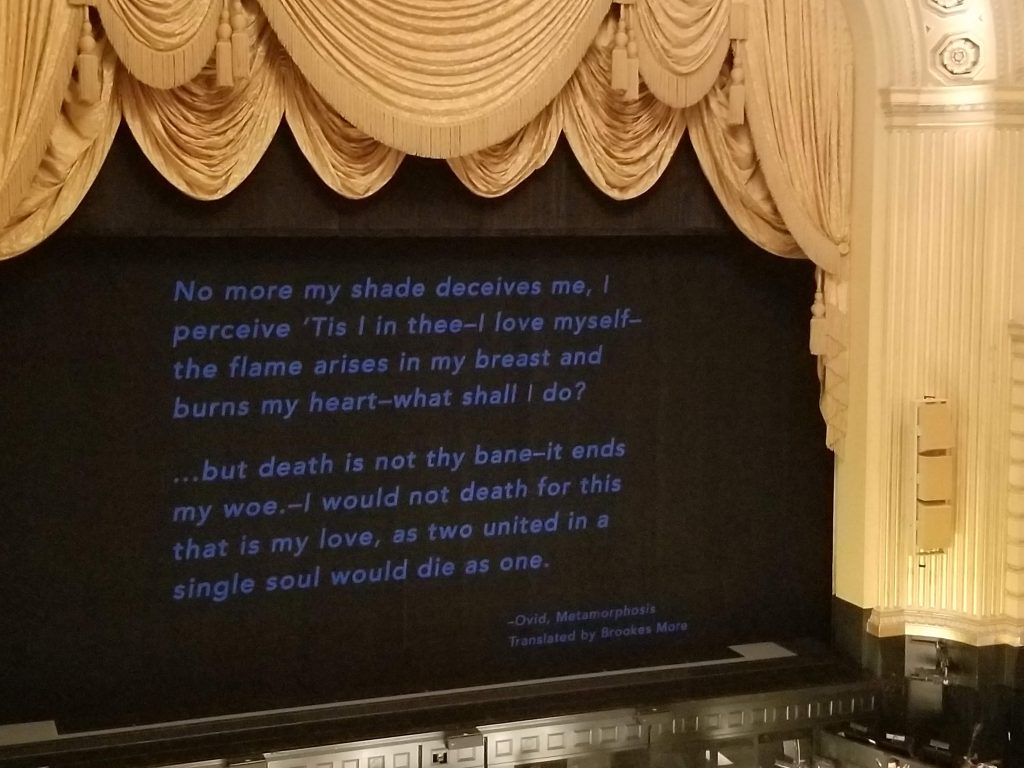Last Saturday we saw program 5 of San Francisco Ballet’s 2019 season, Lyric Voices. It was a mixed bill of new work, two ballets that came out of the 2018 season’s new works festival and one brand new piece.
The entire program was very good. The pieces were complimentary but not derivative and none of them were too long (thankfully!). This is the kind of dancing that San Francisco Ballet excels at, the dancers are confident and energetic in these kinds of pieces. There was a lightness and energy to the way that the dancers executed the interesting and appropriate movement vocabulary.
Your Flesh Shall Be a Great Poem
The first piece, which premiered in the new works festival last spring, was Your Flesh Shall Be a Great Poem by Trey McIntyre. The piece was inspired by a photo of a grandfather who he never knew and dealt with themes of loss and longing for connection.
The movement had a lightness, an airiness to it. McIntyre used a clean, classical movement vocabulary that brought to my mind Balanchine’s mid-twentieth century, neoclassical ballets.
Four of the six movements of the piece very obviously supported the narrative. I have not been able to decipher the literal meaning of other two movements, one of which was my most favorite dance in the piece. It was a pas de trois featured Sasha De Sola, Jennifer Stahl, and one of the male dancers who was not the grandfather character. It was just gorgeous. For some reason, I am stuck on an idea that Sasha and Jennifer were fireflies. Whatever they were, their dancing was powerful, clean, and warm.
I will look forward to seeing this piece again and hope to see more work by Trey McIntyre in San Francisco Ballet’s repertoire.
Bound To
The second piece was Christopher Wheeldon’s contribution to the 2018 new works festival, titled Bound To. The concept for this piece is the way in which we, as a society, are “bound to” technology and disconnected from the people around us.

In the opening movement, the dancers are all mesmerized by their cellphones. When they do interact, at least one of the dancers is completely distracted. The piece then transitions into a series of movements in which the dancers do not have their devices; however, their interactions are still somewhat distant, as if they no longer know how to connect with other people. In the final solo of the series, this dude loses it. Everyone goes back to their phones and leave him for dead.
I found myself wondering how this work will stand the test of time. Will it be something that anyone will want to stage in 20 years? Will it be “of its time” in a good way?
“…two united in a single soul…”
The title of Yuri Possokhov’s world premiere comes from a line in Metamorphoses by Ovid pertaining to the Greek myth of Narcissus (book III). The idea of reflection was explored in virtually every element of the piece and was strongly established by the memorable opening scene in which the orientation and direction of each dancer created a powerful hall-of-mirrors effect.

This ballet was gorgeous. All of the elements were interesting and unexpected – the set, the music, the costumes, and the dancing.
The minimalist set elements were well utilized throughout the work but my favorite effect was at the end of the work. A black-and-white camouflage pattern projected on the floor reflects the image of a skull on the massive metallic teardrop upstage center. That moment was a particularly eerie, powerful, and clever use of the scenic elements.
Daria Novo’s musical composition included several arias by Handel sung by a countertenor (the highest male singing voice) and music by Handel was combined with electronic effects throughout. The singer, Aryeh Nussbaum Cohen, appeared onstage and interacted with the dancers. I thought this was a fantastic and effective way to combine operatic singing with dance. He symbolized another facet of Narcissus. It was like the singer was telling the story as the dancer showed it.
A great night at the ballet was had by all.

Sounds like you really enjoyed your dance weekend. Keep it up. I liked your critique.